Related Research Articles
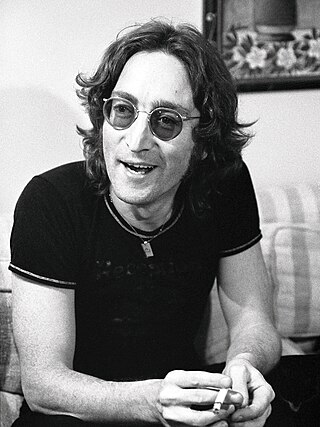
John Winston Ono Lennon was an English singer, songwriter and musician who gained worldwide fame as the founder, co-songwriter, co-lead vocalist and rhythm guitarist of the Beatles. His work included music, writing, drawings and film. His songwriting partnership with Paul McCartney remains the most successful in history.

Yoko Ono is a Japanese multimedia artist, singer, songwriter, and peace activist. Her work also encompasses performance art and filmmaking.

John Lennon/Plastic Ono Band is the debut solo studio album by English musician John Lennon. Backed by the Plastic Ono Band, it was released by Apple Records on 11 December 1970 in tandem with the similarly titled album by his wife, Yoko Ono. At the time of its issue, John Lennon/Plastic Ono Band received mixed reviews overall, but later came to be widely regarded as Lennon's best solo album.

Some Time in New York City is a part-studio, part-live double album by John Lennon and Yoko Ono as Plastic Ono Band that included backing by the American rock band Elephant's Memory. Released in June 1972 in the US and in September 1972 in the UK on Apple Records, it is Lennon's sixth album to be released under his own name, and his fourth with Ono. Like Lennon's previous solo albums, it was co-produced by Lennon, Ono and Phil Spector. The album's agitprop lyrics are politically charged compared to its predecessors, addressing political and social issues and topics such as sexism, incarceration, colonialism, and racism.

Live Peace in Toronto 1969 is a live album by the Plastic Ono Band, released in December 1969 on Apple Records. Recorded at the Toronto Rock and Roll Revival festival, it was the first live album released by any member of the Beatles separately or together. John Lennon and his wife Yoko Ono received a phone call from the festival's promoters John Brower and Kenny Walker, and then assembled a band on very short notice for the festival, which was due to start the following day. The band included Eric Clapton, Klaus Voormann, and drummer Alan White. The group flew from London, and had brief unamplified rehearsals on the plane before appearing on the stage to perform several songs; one of which, "Cold Turkey", was first performed live at the festival. After returning home, Lennon mixed the album in a day.

Unfinished Music No. 2: Life with the Lions is the second of three experimental albums of avant-garde music by John Lennon and Yoko Ono, released in May 1969 on Zapple, a sub label of Apple. It was a successor to 1968's highly controversial Unfinished Music No. 1: Two Virgins, and was followed by the Wedding Album. The album peaked in the United States at number 174, 50 places lower than the previous album. The album, whose title is a play on words of the BBC Radio show Life with The Lyons, was recorded at Queen Charlotte's Hospital in London and live at Cambridge University, in November 1968 and March 1969, respectively. The Cambridge performance, to which Ono had been invited and to which she brought Lennon, was Lennon and Ono's second as a couple. A few of the album's tracks were previewed by the public, thanks to Aspen magazine. The album was remastered in 1997.
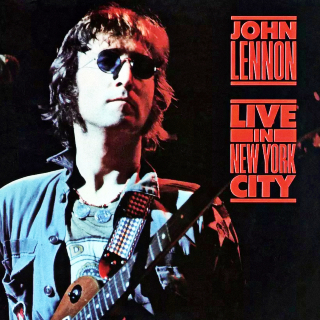
Live in New York City is a posthumous live album by English rock musician John Lennon with the Plastic Ono Elephant's Memory Band. It was prepared under the supervision of his widow, Yoko Ono, and released in 1986 as his second official live album, the first being Live Peace in Toronto 1969.

"Give Peace a Chance" is an anti-war song written by John Lennon, and recorded with the participation of a small group of friends in a performance with Yoko Ono in a hotel room in Montreal, Quebec, Canada. Released as a single in July 1969 by the Plastic Ono Band on Apple Records, it is the first solo single issued by Lennon, released while he was still a member of the Beatles, and became an anthem of the American anti-war movement during the 1970s. It peaked at number 14 on the Billboard Hot 100 and number 2 on the British singles chart.
The Plastic Ono Band was a rock band formed by John Lennon and Yoko Ono in 1969 for their collaborative and solo projects based on their 1968 Fluxus conceptual art project of the same name.

The Bed-ins for Peace were two week-long nonviolent protests against wars, intended as experimental tests of new ways to promote peace. As the Vietnam War raged in 1969, artist Yoko Ono and her husband John Lennon held one protest at the Hilton Hotel in Amsterdam and one at the Queen Elizabeth Hotel in Montreal. The idea is derived from a "sit-in", in which a group of protesters remain seated in front of or within an establishment until they are evicted, arrested, or their requests are met.

"Cold Turkey" is a song written by English singer-songwriter John Lennon, released as a single in 1969 by the Plastic Ono Band on Apple Records, catalogue Apples 1001 in the United Kingdom, Apple 1813 in the United States. It is the second solo single issued by Lennon and it peaked at number 30 on the Billboard Hot 100 and number 14 on the UK Singles Chart. The song's first appearance on an album was Live Peace in Toronto 1969 where the song had been performed live on 13 September 1969 with Lennon reading the lyrics off a clip-board.
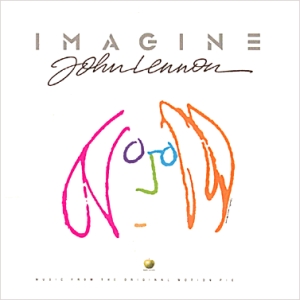
Imagine: John Lennon is a soundtrack album of popular music compiled for the 1988 documentary film Imagine: John Lennon from songs written or co-written by John Lennon. Originally released that year as a double album, it now remains available on one CD.

"The Ballad of John and Yoko" is a song by the English rock band the Beatles that was released as a non-album single in May 1969. It was written by John Lennon and credited to the Lennon–McCartney partnership, and chronicles the events surrounding the wedding of Lennon and Yoko Ono. The song was the Beatles' 17th UK number-one single and their last for 54 years until "Now and Then" in 2023. In the United States, it was banned by some radio stations due to the lyrics' reference to Christ and crucifixion. The single peaked at number 8 on the US Billboard Hot 100. The song has subsequently appeared on compilation albums such as Hey Jude, 1967–1970, Past Masters, and 1.

Yoko Ono/Plastic Ono Band is the debut solo studio album by Japanese artist and musician Yoko Ono, released on Apple Records in December 1970 alongside her husband's album John Lennon/Plastic Ono Band. Ono's album features her vocal improvisations against backing by the Plastic Ono Band, with the exception of the track "AOS", which is backed by the Ornette Coleman Quartet.
Sweet Toronto is a documentary by D.A. Pennebaker of the Toronto Rock and Roll Revival, a one-day festival held September 13, 1969, at Varsity Stadium on the campus of the University of Toronto and attended by some 20,000 people. The event was produced by John Brower and Ken Walker. John Lennon, who seven days later would unofficially resign as a member of the Beatles, played as part of the Plastic Ono Band, whose members also included Yoko Ono, Klaus Voormann, Alan White, and Eric Clapton. Their set was released as the album Live Peace in Toronto 1969.
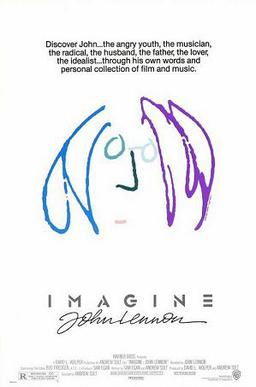
Imagine: John Lennon is a 1988 documentary film about English musician John Lennon. It was released on 7 October 1988, two days before Lennon's 48th birthday.
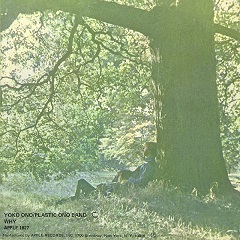
"Why" is a song written by Yoko Ono that was first released on her 1970 Yoko Ono/Plastic Ono Band album. In the U.S. it was also released as the B-side of John Lennon's "Mother" single, taken from his John Lennon/Plastic Ono Band album.
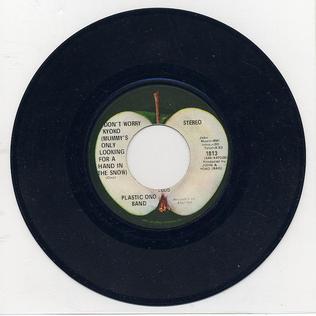
"Don't Worry Kyoko (Mummy's Only Looking for A Hand in the Snow)" is a song by Yoko Ono that was originally released by Plastic Ono Band in October 1969 as the B-side of the "Cold Turkey" single, and was later released on Ono's 1971 album Fly. Several live versions have been released, including on Plastic Ono Band's Live Peace in Toronto 1969 and the John & Yoko/Plastic Ono Band With Elephant's Memory album Some Time in New York City in 1972. An early version was titled "Mum's Only Looking for Her Hand in the Snow". It has been covered by several other artists.
References
- ↑ "Philip French on John Lennon's rise and fall". the Guardian. 2009-07-04. Retrieved 2021-11-05.
- ↑ John & Yoko/Plastic Ono Band book by Yoko Ono and John Lennon, published by Thames & Hudson Ltd, October 2020, pp. 202-203
- ↑ John & Yoko/Plastic Ono Band book by Yoko Ono and John Lennon, published by Thames & Hudson Ltd, October 2020, p. 5
- ↑ "The Beatles Bible - Self-Portrait and Mr & Mrs Lennon's Honeymoon by John Lennon and Yoko Ono are premièred in London". The Beatles Bible. 1969-09-10. Retrieved 2021-11-05.
- ↑ Show: The Magazine of Films and the Arts. H & R Publications. January 1970. p. 50.
- ↑ Peter Doggett (17 December 2009). The Art and Music of John Lennon. Omnibus Press. pp. 230–. ISBN 978-0-85712-126-4.
- ↑ Show: The Magazine of Films and the Arts. H & R Publications. January 1970. p. 50.